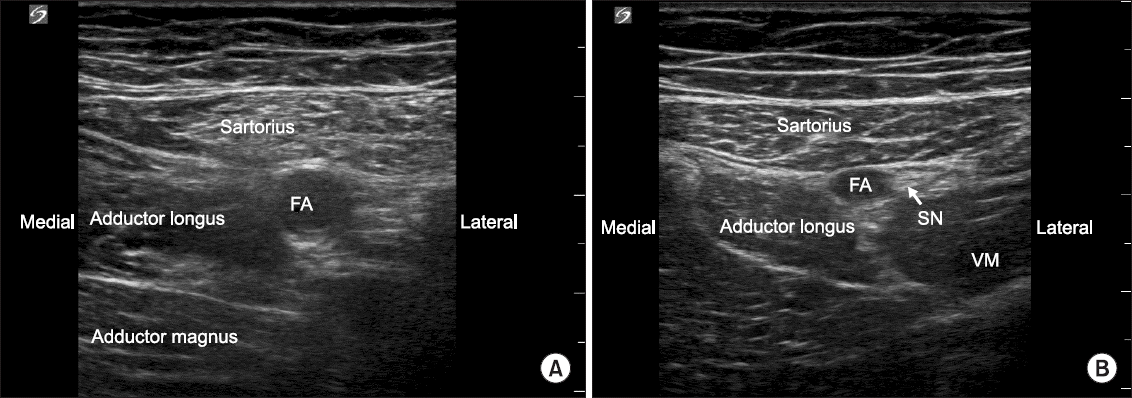1. Terkawi AS, Mavridis D, Sessler DI, Nunemaker MS, Doais KS, Terkawi RS, et al. Pain management modalities after total knee arthroplasty:a network meta-analysis of 170 randomized controlled trials. Anesthesiology. 2017; 126:923–37. DOI:
10.1097/ALN.0000000000001607. PMID:
28288050.
2. Al-Zahrani T, Doais KS, Aljassir F, Alshaygy I, Albishi W, Terkawi AS. Randomized clinical trial of continuous femoral nerve block combined with sciatic nerve block versus epidural analgesia for unilateral total knee arthroplasty. J Arthroplasty. 2015; 30:149–54. DOI:
10.1016/j.arth.2014.07.032. PMID:
25149364.
3. Bendtsen TF, Moriggl B, Chan V, Børglum J. The optimal analgesic block for total knee arthroplasty. Reg Anesth Pain Med. 2016; 41:711–9. DOI:
10.1097/AAP.0000000000000485. PMID:
27685346.
4. Hirasawa Y, Okajima S, Ohta M, Tokioka T. Nerve distribution to the human knee joint:anatomical and immunohistochemical study. Int Orthop. 2000; 24:1–4. DOI:
10.1007/s002640050001. PMID:
10774852. PMCID:
PMC3619852.
5. McIsaac DI, McCartney CJ, Walraven CV. Peripheral nerve blockade for primary total knee arthroplasty:a population-based cohort study of outcomes and resource utilization. Anesthesiology. 2017; 126:312–20. DOI:
10.1097/ALN.0000000000001455. PMID:
27977461.
6. Abdallah FW, Madjdpour C, Brull R. Is sciatic nerve block advantageous when combined with femoral nerve block for post-operative analgesia following total knee arthroplasty?a meta-analysis. Can J Anaesth. 2016; 63:552–68. DOI:
10.1007/s12630-016-0613-2. PMID:
26896282.
7. Kim DH, Beathe JC, Lin Y, YaDeau JT, Maalouf DB, Goytizolo E, et al. Addition of infiltration between the popliteal artery and the capsule of the posterior knee and adductor canal block to periarticular injection enhances postoperative pain control in total knee arthroplasty:a randomized controlled trial. Anesth Analg. 2019; 129:526–35. DOI:
10.1213/ANE.0000000000003794. PMID:
30234517.
8. Kandarian B, Indelli PF, Sinha S, Hunter OO, Wang RR, Kim TE, et al. Implementation of the IPACK (Infiltration between the Popliteal Artery and Capsule of the Knee) block into a multimodal analgesic pathway for total knee replacement. Korean J Anesthesiol. 2019; 72:238–44. DOI:
10.4097/kja.d.18.00346. PMID:
30776878. PMCID:
PMC6547229.
9. Kopp SL, Børglum J, Buvanendran A, Horlocker TT, Ilfeld BM, Memtsoudis SG, et al. Anesthesia and analgesia practice path-way options for total knee arthroplasty:an evidence-based review by the American and European Societies of Regional Anesthesia and Pain Medicine. Reg Anesth Pain Med. 2017; 42:683–97. DOI:
10.1097/AAP.0000000000000673. PMID:
29053504.
10. Sawhney M, Mehdian H, Kashin B, Ip G, Bent M, Choy J, et al. Pain after unilateral total knee arthroplasty:a prospective randomized controlled trial examining the analgesic effectiveness of a combined adductor canal peripheral nerve block with periarticular infiltration versus adductor canal nerve block alone versus periarticular infiltration alone. Anesth Analg. 2016; 122:2040–6. DOI:
10.1213/ANE.0000000000001210. PMID:
27028771.
11. Zhang Y, Tan Z, Liao R, Zhou Z, Kang P, Cheng X, et al. The prolonged analgesic efficacy of an ultrasound-guided single-shot adductor canal block in patients undergoing total knee arthro-plasty. Orthopedics. 2018; 41:e607–14. DOI:
10.3928/01477447-20180621-05. PMID:
29940055.
12. Meier AW, Auyong DB, Yuan SC, Lin SE, Flaherty JM, Hanson NA. Comparison of continuous proximal versus distal adductor canal blocks for total knee arthroplasty:a randomized, double-blind, noninferiority trial. Reg Anesth Pain Med. 2018; 43:36–42. DOI:
10.1097/AAP.0000000000000692. PMID:
29140959.
13. Ilfeld BM. Continuous peripheral nerve blocks:an update of the published evidence and comparison with novel, alternative analgesic modalities. Anesth Analg. 2017; 124:308–35. DOI:
10.1213/ANE.0000000000001581. PMID:
27749354.
14. Sztain JF, Khatibi B, Monahan AM, Said ET, Abramson WB, Gabriel RA, et al. Proximal versus distal continuous adductor canal blocks:does varying perineural catheter location influence analgesia?A randomized, subject-masked, controlled clinical trial. Anesth Analg. 2018; 127:240–6. DOI:
10.1213/ANE.0000000000003422. PMID:
29750695.
15. Elkassabany NM, Antosh S, Ahmed M, Nelson C, Israelite C, Badiola I, et al. The risk of falls after total knee arthroplasty with the use of a femoral nerve block versus an adductor canal block:a double-blinded randomized controlled study. Anesth Analg. 2016; 122:1696–703. DOI:
10.1213/ANE.0000000000001237. PMID:
27007076.
16. Szűcs S, Morau D, Sultan SF, Iohom G, Shorten G. A comparison of three techniques (local anesthetic deposited circumferential to vs. above vs. below the nerve) for ultrasound guided femoral nerve block. BMC Anesthesiol. 2014; 14:6. DOI:
10.1186/1471-2253-14-6. PMID:
24460975. PMCID:
PMC3933203.
17. Burckett-St Laurant D, Peng P, Girón Arango L, Niazi AU, Chan VW, Agur A, et al. The nerves of the adductor canal and the in-nervation of the knee:an anatomic study. Reg Anesth Pain Med. 2016; 41:321–7. DOI:
10.1097/AAP.0000000000000389. PMID:
27015545.
18. Kim DH, Lin Y, Goytizolo EA, Kahn RL, Maalouf DB, Manohar A, et al. Adductor canal block versus femoral nerve block for total knee arthroplasty:a prospective, randomized, controlled trial. Anesthesiology. 2014; 120:540–50. DOI:
10.1097/ALN.0000000000000119. PMID:
24401769.
19. Kuang MJ, Ma JX, Fu L, He WW, Zhao J, Ma XL. Is adductor canal block better than femoral nerve block in primary total knee arthroplasty?A GRADE analysis of the evidence through a systematic review and meta-analysis. J Arthroplasty. 2017; 32:3238–48.e3. DOI:
10.1016/j.arth.2017.05.015. PMID:
28606458.
21. Runge C, Moriggl B, Børglum J, Bendtsen TF. The spread of ultra-sound-guided injectate from the adductor canal to the genicular branch of the posterior obturator nerve and the popliteal plexus: a cadaveric study. Reg Anesth Pain Med. 2017; 42:725–30. DOI:
10.1097/AAP.0000000000000675. PMID:
28937534.
22. Hanson NA, Allen CJ, Hostetter LS, Nagy R, Derby RE, Slee AE, et al. Continuous ultrasound-guided adductor canal block for total knee arthroplasty:a randomized, double-blind trial. Anesth Analg. 2014; 118:1370–7. DOI:
10.1213/ANE.0000000000000197. PMID:
24842182.
23. Mariano ER, Kim TE, Wagner MJ, Funck N, Harrison TK, Walters T, et al. A randomized comparison of proximal and distal ultrasound-guided adductor canal catheter insertion sites for knee arthroplasty. J Ultrasound Med. 2014; 33:1653–62. DOI:
10.7863/ultra.33.9.1653. PMID:
25154949.
24. Kardash KJ, Noel GP. The SPANK block:a selective sensory, single-injection solution for posterior pain after total knee arthroplasty. Reg Anesth Pain Med. 2016; 41:118–9. DOI:
10.1097/AAP.0000000000000330. PMID:
26678763.
25. Choi WJ, Hwang SJ, Song JG, Leem JG, Kang YU, Park PH, et al. Radiofrequency treatment relieves chronic knee osteoarthritis pain:a double-blind randomized controlled trial. Pain. 2011; 152:481–7. DOI:
10.1016/j.pain.2010.09.029. PMID:
21055873.

